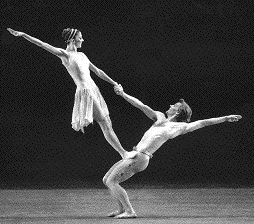|
|||||
|
|
|||||
 http://insaniescreed.tumblr.com/post/63535880934 figure 1 |
|||||
|
The basics of the speed
of turns
 http://www.peterwerner.net/dance.html Not only
must dancers maintain balance while being
stationary, but dancers must also maintain
balance while turning.
Dancers must
learn to control how fast they turn, and for how long. here are somethings to remember before we continue.
I is
basically the measurement of the level of
difficulty it takes or something to start
moving. So when finding I, we must take to
account the mass
of the dancer. The grater the mass, the larger an object's inertia is. And when I is larger, the spin rate is smaller. Inertia is also dependent on the radius of an object. In a dancer's case, while she is spinning, placing the foot to the knee and twisting the leg out will decrease the dancers speed. This is because inertia gets larger, causing angular velocity to slow down. If the dancer, pulls her leg inward, she will spin faster. (refer to the clip above, figure 1) The torque needed to begin the turn can be exerted against the floor by two feet with a distance d. simply speaking, when pushing off the ground, the ground pushes back, allowing the dancer to spin. |
|||||
| |
|||||
| |
|||||
|
|


